CPT Service Dog Program Featured Nationally in People Magazine

March 27, 2020
We are proud to announce that the CPT Service Dog Program has been acknowledged nationally in the January 13, 2020 issue of People Magazine and the January 16, 2020 publication of People.com.
Our Client’s Story
The People article describes a 20-year old, female CPT client who suffers from schizophrenia. Her schizophrenia symptoms include frightening auditory and visual hallucinations of knife-wielding persons intending to do her harm. Fortunately, the client was early in the onset of experiencing severe hallucinations.
Consequently, she had not reached a fully psychotic stage, where she could no longer discriminate her voices and visions from reality. Nevertheless, fear provoked by the hallucinations was frequently incapacitating, which greatly affected her home life, social life, scholastic performance, and general emotional state.
Psychiatric treatment was beneficial, but insufficient. Therefore, her parents contacted CPT about training the family’s existing pet, Hank, a Lab/Rottweiler mix, to become a service dog for their daughter.
Personalized Service Dog Training
CPT’s Service Dog Program is highly personalized. Depending upon client preference or need, we may evaluate and train an existing pet or locate, evaluate, and train a puppy or young adult dog from a breeder or shelter. Furthermore, rather than pre-train dogs to generic specifications, each CPT service dog is custom-trained per a program uniquely designed for each client.
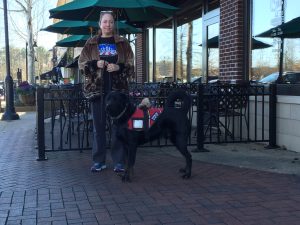
Please note that CPT respects the confidentiality of our service dog clients. This story was approved by our client, who wishes to improve public knowledge of schizophrenia and the benefits provided by psychiatric service dogs.
The preferences and task behaviors are customized, as are the program modalities. The CPT Board Train Service Dog Program emphasizes board training followed by post-board handler training. In contrast, the CPT Hands-On Service Dog Program includes a flexible combination of group class, private lessons at CPT, in-home private lessons, public venue private lessons, and/or FaceTime lessons. The Hands-On Program may also include board training when/if needed or requested.
Thus, the CPT Service Dog Program is highly adaptable to the needs and budget of our clients, as well as their geographic location. Geography is rarely an obstacle. CPT service dog clients reside throughout the United States and our client base also includes a Canadian client.
The Introductory Interview
With the permission of their adult-age daughter, CPT first met with the parents to conduct a thorough medical interview. During the interview we discussed the history, specifics, and nuances of their daughter’s psychiatric condition. The interview included chronologies of symptoms, diagnosis, and treatment; effects of cognitive and pharmaceutical treatment; residential, social, and lifestyle information; the impact the disability has on general health, lifestyle, and life activities; the desired role for the dog; requested timelines and milestones; and the specific task behaviors to optimally mitigate the limitations and effects of her disability, maximize an improvement in her overall quality of life, and best enhance her probability for long-term social, scholastic, and career success.
The process is unique to CPT. We know of no other private service dog company or nonprofit organization that undertakes the rigors and personalization employed by CPT.
The detailed medical interview is invaluable when constructing a customized lesson plan for the dog. Just as important, the medical interview educates CPT staff about the idiosyncrasies unique to each client’s disability.
An Educated Staff Knowledgeable About Our Clients and Their Disabilities
Furthermore, our training staff receives general medical information related to each pertinent disability. In the case of the 20-year old discussed in People, we desire our trainers to better understand the genetic and environmental causes of schizophrenia, the typical symptoms and characteristics, treatment options, and demographic data. This depth of knowledge better enables our trainers to work with each client upon the conclusion of a board train or during the entirety of a Hands-On Program.
Evaluating the Candidate Animal
Upon the establishment of program specifications we next had a CPT Head Trainer evaluate Hank. The proprietary CPT evaluation process is extensive. Through years of experience, observation, data collection, innovation, knowledge from attending scientific conferences, shrewdness improving attributes from several validated tests, and wisdom acquired while adapting a $1.1 million military-funded fMRI study of service dogs co-authored by CPT and Dog Star Technologies owner Mark Spivak, we believe we have developed the finest service dog evaluation protocol in the industry.

During the 2 – 2.5 hour examination we assess adult animals in more than 50 criteria related to temperament, aptitude, behavior, and structure, including: obedience, observable orthopedic health, sensory health, general health, housebreaking behavior, general manners, energy, cooperation, affiliation, noise tolerance, tactile tolerance, restraint tolerance, object tolerance, novelty tolerance, outdoor environmental tolerance, tolerance of urban conditions, tolerance of isolation, behavior with unfamiliar persons, behavior with unfamiliar dogs, proprioceptive confidence and competence, aptitude for play training, aptitude for food training, olfactory drive and aptitude, problem solving, and inhibitory control.
At the conclusion of the evaluation we grade the dog A, B, C, or D, with pluses or minuses. An A+ or A dog is an exemplary candidate, with no severe or significant faults; an A- dog is a very good candidate, with only a few minor faults and no shortcomings in criteria significant to the task role; a B+ to B- dog is a good to fair candidate, provided the dog shows improvement in identified weak areas; a C+ to C- dog exhibited multiple weaknesses, including some severe faults or shortcomings in criteria highly significant to the task role, where the dog has a much lower probability for success; and a D+ to D- dog is one we don’t advise training as a service animal, due to the identification of multiple severe weakness, including several in criteria significant to the task role.
The evaluation is tantamount to when a pro sports team interviews college prospects and their coaches, reviews videotape, measures athletes at the league combine, and invites them for a personal tryout. Before drafting an athlete and investing dollars in a contract the team wishes to ascertain that the player maximize the team’s probability of receiving a high return-on-investment (ROI).
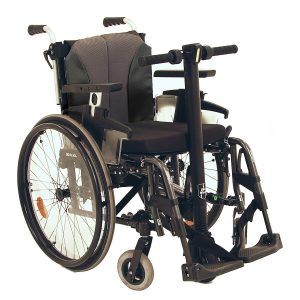
Source: Wikimedia Commons- Nick Yudin.
Service dogs need to remain calm, composed, confident, cooperative, and focused on task, regardless of the environment. That means regardless whether the environment is indoors or outdoors, regardless of weather conditions, and regardless of floor or ground substrates, noises, objects, vehicles, persons, dogs, cats, or wildlife present in the environment a service dog can not exhibit out of context anxiety, excitability, or aggression.
Moreover, the dog must display the aptitude and structure to proficiently complete task behaviors. Just like not every person has the innate ability to be a star NBA athlete, not every dog has the phenotype to be a stellar service dog candidate, regardless of the quality of training.
Therefore, the CPT evaluation is essential for providing our clients information to judiciously determine whether their existing pet, another adult candidate, or a puppy from a litter has the mettle to become an ideal service dog. Furthermore, when a dog has identified weaknesses that may be adjustable, the evaluation is imperative when sapiently designing a behavior modification plan that provides the highest probability of improving the dog’s performance.
Hank’s Initial Board Train
During Hank’s evaluation he exhibited certain traits and behaviors that prompted concern whether he was a viable candidate. Consequently, we advised the client that before she invests in a full service dog board train she should purchase only a preliminary board train, where we focus on modifying the identified weakness. We ascertained that the weaknesses may be difficult to overcome, but that they are likely not insurmountable.
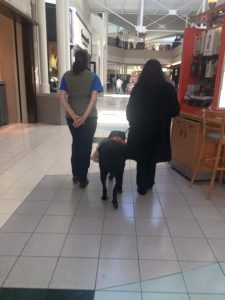
Source: photo submitted by client.
The first 3 weeks of Hank’s board train failed to achieve desired results. We reported the bad news to the client, but said that we weren’t ready to give up. Then, during the 4thweek Hank unexpectedly had a “Eureka moment.” Whereas Hank was initially lethargic, disinterested, and stubborn, he rapidly became appropriately energetic, motivated, cooperative, and eager to learn.
Subsequently, CPT Trainer Lisa Carroll and CPT Head Trainer Mark Spivak re-evaluated Hank and informed the client that we recommend enrolling Hank for service dog training. The client was very pleased with his progress, as she too was initially uncertain whether Hank would succeed.
CPT’s Mark Spivak opined, “Lisa did a great job training Hank! And I don’t dispense accolades lightly.”
Mark continued, “I doubted that Hank would exhibit such a significant level of improvement. Moreover, I have an ethical duty to be honest with customers regarding their dog’s chance to succeed. I don’t want to take money from anybody unless I believe their dog and their program has a high probability of meeting objectives. Therefore, the magnitude of Hank’s progress was a very pleasant surprise.”
Hank’s Service Dog Board Train
Once Hank passed muster in his preliminary board train, we converted his lesson plan focus to the task behaviors specified in the client’s CPT Service Dog Contract. During this phase Hank remained cooperative, motivated, and eager to learn, which accelerated his progress.
Typically, a final-stage psychiatric service dog board train requires 4 – 6 months of intensive training. However, Hank was a prodigious student and required only 3 months.
Hank’s final-stage board train emphasized advanced obedience; fixing remaining household and general manners problems; continued socialization with persons, dogs, cats, and environmental stimuli; and teaching the referenced task behaviors. The task behaviors are the true heart of each service dog program, as they are the component that impacts the client most in coping with her disability.
Yet, before teaching the task behaviors we had to ensure that Hank was reliably obedient and well-mannered. Although the formal assistance behaviors are the heart that figuratively pumps blood into a program, the foundation behaviors are the body that provides support for the heart, since they are the behaviors that are most frequently relevant during daily client-dog interactions and public access outings.
A service dog must be good at doing something, but must also be good at doing nothing. Regardless of how well a dog performs its assistance behaviors, if the dog won’t walk on-leash without pulling, remains distracted or nervous when exposed to environmental stimuli, or remains restless when asked to down-stay for long periods, then the dog has only minimal practical utility.
Hank flew through his final-stage foundation training, during which we focused on generalizing his obedience, manners, and socialization behaviors. “Generalization” is the process of extending reliable and responsive performance from a familiar, pristine environment to multifarious environments- public, private, commercial, and residential.
Concurrently, we introduced Hank’s task behaviors at Lisa’s home, where Hank resided during his board train. Hank’s primary assistance behaviors included multiple tactile, deep-pressure behaviors, most of which he needed to perform automatically when observing distress from the recipient. In addition, he should immediately and competently perform all the behaviors once receiving a command.
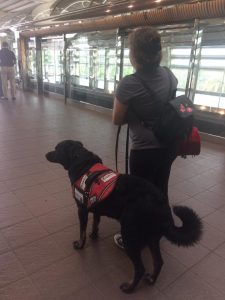
We trained Hank to perform the behaviors automatically via role-playing exercises that integrated information acquired during the medical interview. By knowing details germane to the characteristics of the specific recipient’s panic episodes, we could mimic the contexts and her behavior to most effectively prepare Hank. Similarly, we educated Hank to recognize and automatically interrupt self-harm episodes.
In addition, Hank learned 4-sided buffering behaviors, whereby the recipient could promptly position Hank between herself and the location of the “attacker” in her hallucination. Hank also learned to search a room to signal the presence of a human who may be visible or hidden behind a room or closet door. Furthermore, he learned to turn-on lights so that the recipient could more comfortably enter a formerly dark room.
Once Hank became adept at performing the task behaviors in quiet, everyday environments, the next step accentuated generalization of the task behaviors. Thus, we took Hank to parks, urban streets, offices, hospitals, schools, and malls to challenge his performance in increasingly difficult environments and situations.
When Hank met objectives for all behaviors with Lisa handling Hank, then it was time for the final-stage of the process- owner/recipient training.
The Final Stage: Training the Client
It is important that Hank work proficiently for Lisa. However, it is more important that Hank work capably for the client. This is another area where CPT excels- educating the human end of the leash.
Typically, service dog turnover sessions consist of 2 – 6 half-day sessions. The number of sessions depends upon the disability affecting the recipient, complexity of the program, number of task behaviors in the program, aptitude of the recipient, and the preferences of the recipient. Psychiatric programs tend to be on the lower side of the range, whereas mobility programs generally fall within the higher side of the range.
Fortunately, Hank’s owner was an excellent student who quickly learned the handling mechanics, human-dog communication protocols, and management protocols required to maximize Hank’s performance and utility. Within just 2 days she felt ready to have Hank return home as her full-time service animal.
Hank is a Life Changer
The recipient was affected by schizophrenia at a very young age. The average age of onset for males is 18 and for females 25.[1] However, the recipient’s hallucinations began when she was just 14 years of age.
Due to her condition, she lived in fear of being attacked by voices and visions that she cognitively understood weren’t real, but that she couldn’t control; was afraid of entering familiar and unfamiliar rooms; felt that she was less of a person in comparison to peers; believed that she wasn’t loved or respected by family and friends; suffered a tremendous decrease in self-esteem; started cutting herself with razor blades; developed suicidal thoughts; twice attempted suicide; withdrew from her public high school; and entered long-term hospitalization.

Source: photo submitted by client.
However, Service Dog Hank spawned an incredible metamorphosis in her quality of life and outcomes. Hank’s presence and formal task behaviors have reduced the frequency, severity, and duration of panic episodes. She now rarely cuts herself, both because she has a more positive outlook on life, but also because Hank effectively interrupts her behavior. She enters rooms confidently, because Hank confirmed that a stranger wasn’t present and because he turned on the lights for her prior to her entrance. When she feels the onset of voices or visions, Hank “protects” her by placing himself in a defensive position, which often extinguishes the hallucination and at the minimum reduces its emotional impact.
Perhaps more importantly, after spending 6 months in a psychiatric in-patient program, the recipient returned to her public high school and subsequently graduated. Hank even joined her on stage when she received her diploma, which earned a huge ovation from fellow students and parents in the audience who were familiar with her story.
She is presently working as a certified nursing assistant (CNA) at a local rehabilitation center, has much higher self-esteem, wants to stay alive, and has a much more optimistic outlook for the future.
According to her father, “I honestly don’t believe we would be where we are without Hank’s help and support.”
He further elaborated, “They have a special bond. Without a doubt Hank has given her a renewed chance at a semi-normal life. Thank you for all you and the CPT family continue to do!”
Understanding Schizophrenia
Since there is a general lack of knowledge about schizophrenia and frequent misperception regarding schizophrenics, I will provide some information.
Schizophrenia is the world’s most common psychotic mental health disorder and one of the top 15 disabilities worldwide[2]. A psychosis is a mental health disorder caused by dysfunction of dopaminergic neurotransmission, characterized symptomatically by disordered thought, delusions, and hallucinations, where the patient has difficulty discriminating reality.[3] Moreover, schizophrenics have a high co-morbidity with other mental health disorders, including depression (50%), substance abuse disorders (47%), post-traumatic stress disorder (29%), obsessive-compulsive disorder (23%), and panic disorder (15%).[4]
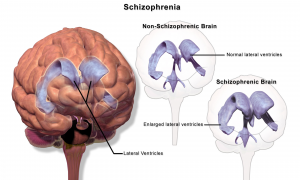
Source: Wikimedia Commons- Bruce Blaus
The genesis is believed to be a combination of genetic factors and environmental factors related to stress, parental age, poor prenatal maternal nutrition, infection, and/or early onset marijuana use, whereupon the combination prompts dopaminergic dysregulation.[5] The disease tends to begin in early adulthood and then progresses. Males typically develop symptoms earlier than females and are more prone to the condition by a ratio of 1.4 – 1.[6] It is estimated that 0.25% – 0.64% of Americans suffer from schizophrenia,[7]which equates to between 818,000 – 2,092,800 persons.
Only a minority of schizophrenics commit violent criminal offenses (13.2%). Yet, the number is higher than for the general population (5.3%). The risk is highest if a schizophrenic has a co-morbid substance abuse disorder (27.6%), whereas the number is significantly lower for all other schizophrenics (8.5%).[8]
Treatment generally consists of antipsychotic medications, cognitive therapy, and social support.[9] There is also evidence that a service dog may provide adjunctive therapeutic benefit.[10] The earlier treatment commences the greater the probability of positive impact.[11]
Approximately half of persons treated recover or significantly improve.[12] For those without access to treatment or where treatment fails to facilitate improvement life can be very difficult.
Unemployment, poverty, victimization, and homelessness are common to persons suffering from schizophrenia. Schizophrenics may comprise as much as 33% of the USA’s estimated homeless population of 552,830 persons.[13][14]
Moreover, the debilitating nature of the condition dramatically affects lifespan. Schizophrenics have an average lifespan 20 years less than the general population.[15] Suicide is a major cause of premature death. 4.9% of schizophrenics commit suicide.[16] In contrast, suicide is much less common in the general population. In 2018, suicide comprised 1.7% of all deaths in the United States.[17]
Consequently, we are highly pleased that CPT trained service dog Hank is playing a valuable role in improving the long-term outcomes for our client.
CPT Trains Service Dogs to Benefit a Variety of Disabled Persons
In addition to psychiatric service dogs, CPT trains service dogs for persons with mobility, cognitive, neurological, physiological, metabolic, congenital, and sensory disabilities. Recipients have ranged from 4 years of age to senior citizens.
CPT trained service dogs assist clients with a myriad of disabilities, including (in alphabetical order): 16P11.2 deletion syndrome, Acoustic sensory processing disorder, Agoraphobia, Amyotrophic lateral sclerosis, Anaphylactic allergy response, Apraxia of speech, Asperger syndrome, Attention deficit hyperactivity disorder, Autism, Autism spectrum disorder, Avoidant personality disorder, Bipolar disorder, Borderline personality disorder, Bulimia nervosa, Cancer, Carotid dissection, Cerebral palsy, Chiari malformation, Chronic pain syndrome, Complex regional pain syndrome, Congenital agenesis of the corpus callosum, Degenerative disc disease, Dissociative disorder, Eating disorder, Ehlers-Danlos syndrome, Dysautonomia, Emotional dysregulation, Epilepsy, Executive function disorder, Fibromyalgia, Fine motor delay, General anxiety disorder, Global developmental delay, Gross motor delay, Hearing impairment, Hemianopsia, Hydrocephalus, Hypersomnia, Hypokalemic periodic paralysis, Hypotonia, Kleine-Levin syndrome, Lupus erythematosus, Lyme disease, Major depressive disorder, Mast cell activation syndrome (MCAS), Meniere’s disease, Migraine headaches, Military sexual trauma, Mitochondrial disorder, Monosomy 9p, Narcissistic personality disorder, Narcolepsy, Neurocardiogenic syncope, Neuropathy, Obsessive-compulsive disorder, Osteoarthritis, Panic disorder, Paraplegia, Parkinson’s disease, Pervasive developmental disorder, Post-Traumatic stress disorder (PTSD), Postural orthostatic tachycardia syndrome (POTS), Primary immunodeficiency disease, Primary lateral sclerosis, Pyridoxine dependent epilepsy, Quadriplegia, Rape trauma syndrome, Reactive attachment disorder, Reflexive sympathetic dystrophy, Rheumatoid arthritis, Schizoaffective disorder, Schizophrenia, Sensory integration dysfunction, Sensory neural hearing loss, Sensory processing disorder, Social anxiety disorder, Spastic diplegia, Spinal cord injury, Spinal muscular atrophy (SMA), Stroke, Substance abuse disorder, SYNGAP1, Traumatic brain injury (TBI), Vasovagal syncope, and Vision impairment (partial).
Beyond the 80+ disabilities listed above for which CPT has benefited clients with trained service dogs, CPT has trained a grief therapy dog for a funeral home and is in the process of training a diabetic alert dog for a client with Type 2 diabetes mellitus.
Contacting CPT
If you believe a personalized CPT service dog program will improve the quality of your life or the life of a family member, please fill out the contact form linked in this sentence. We will then reply with a program description and price estimate.
Alternatively, feel free to contact CPT by phone (404-236-2150) to schedule a Phase I Service Dog Meeting. When calling, please note that CPT office hours are M – F from 9 am – 4 pm.
© Comprehensive Pet Therapy, Inc., March 2020. All rights reserved.
[1]Sham PC, MacLean CJ, and Kendler KS, “A Typological Model of Schizophrenia Based on Age at Onset, Sex, and Familial Morbidity,” Acta Psychiatrica Scandinavica, Feb 1994, 89(2): 135-141. https://www.ncbi.nlm.nih.gov/pubmed/8178665?dopt=Abstract
[2]“Global, Regional, and National Incidence, Prevalence, and years Lived with Disability for 328 Diseases and Injuries for 195 Countries, 1990 – 2016: A Systematic Analysis for the Global Burden of Disease Study 2016,” Lancet, Sep 16, 2017, 390 (10100): 1211-1259. https://www.thelancet.com/journals/lancet/article/PIIS0140-6736(17)32154-2/fulltext
[3]Owen MJ, Sawa A, Mortensen PB, “Schizophrenia,” Lancet, July 2016, 388 (10039): 86–97. https://www.ncbi.nlm.nih.gov/pmc/articles/PMC4940219/
[4]Buckley PF, Miller BJ, Lehrer DS, Castle DJ, “Psychiatric Comorbidities and Schizophrenia,” Schizophrenia Bulletin, March 2009, 35 (2): 383-402. https://www.ncbi.nlm.nih.gov/pmc/articles/PMC2659306/
[5]Owen MJ, Sawa A, Mortensen PB, “Schizophrenia,” Lancet, July 2016, 388 (10039): 86–97. https://www.ncbi.nlm.nih.gov/pmc/articles/PMC4940219/
[6]Picchioni MM, Murray RM, “Schizophrenia,” British Medical Journal, July 2007, 335 (7610): 91-5. https://www.ncbi.nlm.nih.gov/pmc/articles/PMC1914490/
[7]“Schizophrenia,” National Institute of Mental Health, https://www.nimh.nih.gov/health/statistics/schizophrenia.shtml#part_154880
[8]Fazel, S, Langstrom N, Hjern A, Grann M, Lichtenstien M, “Schizophrenia, Substance Abuse, and Violent Crime,” JAMA, May 20, 2009, 301 (19): 2016-2023. https://www.ncbi.nlm.nih.gov/pmc/articles/PMC4905518/
[9]Weiden PJ, “Beyond Psychopharmacology: Emerging Psychosocial Interventions for Core Symptoms of Schizophrenia,” Focus- The Journal of Lifelong Learning in Psychiatry, July 8, 2016, 14 (3): 315-327. https://www.ncbi.nlm.nih.gov/pmc/articles/PMC6526802/
[10]Lloyd J, Johnston L, Lewis J, “Psychiatric Assistance Dog Use for People Living with Mental Health Disorders,” Frontiers in Veterinary Science, June 6, 2019, 6:166. https://www.ncbi.nlm.nih.gov/pmc/articles/PMC6563823/
[11]McGlashan TH, “Early Detection and Intervention of Schizophrenia: Rationale and Research,” British Journal of Psychiatry, 1998, 172 (33): 3-6. https://www.ncbi.nlm.nih.gov/pubmed/9764119
[12]Vita A, Barlati S, “Recovery from Schizophrenia: Is it Possible?” Current Opinion in Psychiatry, January 2018, 31 (3): 1. https://www.researchgate.net/publication/323351554_Recovery_from_schizophrenia_Is_it_possible
[13]“Schizophrenia Facts and Statistics,” http://www.schizophrenia.com/szfacts.htm
[14]“The State of Homelessness in America, “ The Council of Economic Advisors, September 2019. https://www.whitehouse.gov/wp-content/uploads/2019/09/The-State-of-Homelessness-in-America.pdf
[15]Laursen TM, Nordentoft M, Mortensen PB, “Excess Early Mortality in Schizophrenia,” Annual Review of Clinical Psychology, 2014, 10: 425-48. https://pubmed.ncbi.nlm.nih.gov/24313570/
[16]Palmer BA, Pankratz VS, Bostwick JM, “The Lifetime Risk of Suicide in Schizophrenia: A Reexamination,” Archives of General Psychiatry, March 2005, 62 (3): 247-253. https://www.ncbi.nlm.nih.gov/pubmed/15753237/
[17]“Mortality in the United States 2018” Centers for Disease Control. https://www.cdc.gov/nchs/data/databriefs/db355_tables-508.pdf


